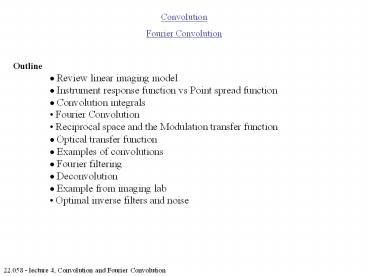Convolution - PowerPoint PPT Presentation
Title:
Convolution
Description:
The Point Spread Function (PSF) is a spatially invariant approximation of the IRF. ... Some Properties of the Convolution. commutative: associative: ... – PowerPoint PPT presentation
Number of Views:1586
Avg rating:3.0/5.0
Title: Convolution
1
Convolution Fourier Convolution
- Outline
- ? Review linear imaging model
- ? Instrument response function vs Point spread
function - ? Convolution integrals
- Fourier Convolution
- Reciprocal space and the Modulation transfer
function - ? Optical transfer function
- ? Examples of convolutions
- ? Fourier filtering
- ? Deconvolution
- ? Example from imaging lab
- Optimal inverse filters and noise
2
Instrument Response Function
The Instrument Response Function is a conditional
mapping, the form of the map depends on the point
that is being mapped. This is often given the
symbol h(rr). Of course we want the entire
output from the whole object function, an
d so we need to know the IRF at all points.
3
Space Invariance
Now in addition to every point being mapped
independently onto the detector, imaging that the
form of the mapping does not vary over space (is
independent of r0). Such a mapping is called
isoplantic. For this case the instrument
response function is not conditional. The
Point Spread Function (PSF) is a spatially
invariant approximation of the IRF.
4
Space Invariance
Since the Point Spread Function describes the
same blurring over the entire sample, The
image may be described as a convolution, or,
5
Convolution Integrals
Lets look at some examples of convolution
integrals, So there are four steps in
calculating a convolution integral 1. Fold
h(x) about the line x0 2. Displace h(x) by
x 3. Multiply h(x-x) g(x) 4. Integrate
6
Convolution Integrals
Consider the following two functions 1.
Fold h(x) about the line x0 2. Displace
h(x) by x
x
7
Convolution Integrals
8
Convolution Integrals
Consider the following two functions
9
Convolution Integrals
10
Some Properties of the Convolution
commutative associative multiple
convolutions can be carried out in any
order. distributive
11
Convolution Integral
Recall that we defined the convolution integral
as, One of the most central results of Fourier
Theory is the convolution theorem (also called
the Wiener-Khitchine theorem. where,
12
Convolution Theorem
In other words, convolution in real space is
equivalent to multiplication in reciprocal space.
13
Convolution Integral Example
We saw previously that the convolution of two
top-hat functions (with the same widths) is a
triangle function. Given this, what is the
Fourier transform of the triangle function?
?
14
Proof of the Convolution Theorem
The inverse FT of f(x) is, and the FT of the
shifted g(x), that is g(x-x)
15
Proof of the Convolution Theorem
So we can rewrite the convolution
integral, as, change the order of integration
and extract a delta function,
16
Proof of the Convolution Theorem
or, Integration over the delta function selects
out the kk value.
17
Proof of the Convolution Theorem
This is written as an inverse Fourier
transformation. A Fourier transform of both
sides yields the desired result.
18
Fourier Convolution
19
Reciprocal Space
real space
reciprocal space
20
Filtering
We can change the information content in the
image by manipulating the information in
reciprocal space. Weighting function in
k-space.
21
Filtering
We can also emphasis the high frequency
components. Weighting function in
k-space.
22
Modulation transfer function
23
Optics with lens
24
Optics with lens
25
Optics with lens
26
Optics with lens 2D FT
27
Optics with lens Projections
28
Optics with lens Projections
29
Optics with pinhole
30
(No Transcript)
31
2D FT
32
Optics with pinhole Projections
33
Projections
34
Deconvolution to determine MTF of Pinhole
35
FT to determine PSF of Pinhole
36
Filtered FT to determine PSF of Pinhole































